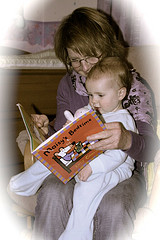Last week, after welcoming my new grandson into the world, I brought my 22 month old grand-daughter back to our house for a couple days. Of course – of course! – I took her to story time at our local library.
Baby – Toddler Story Time
If you want to write literature for the youngest, every so often, you should sit in on one of these story times.
In the twenty minute session, the librarian started with a simple clapping song:
Let’s all clap ’cause XXX came, XXX came, XXX came.
Let’s all clap ’cause XXX came, XXX came today.
 Each child’s name was called around the circle of about a dozen kids and parents. Right away, she had her audience interested (sort of).
Each child’s name was called around the circle of about a dozen kids and parents. Right away, she had her audience interested (sort of).
This was followed by other songs and clapping, sometimes with a puppet, sometimes with props for each child to hold. Some of the songs were illustrated by a book, but some where just songs with something else as a prop. For example, when she sang “The Itsy Bitsy Spider,” each child waved a simple noisemaker to make rain sounds.
Next, the librarian introduced simple nursery rhymes . I hadn’t seen this one before.
With the motions:
Child holds out hand. With your index finger, make a circle on the child’s palm while saying:
The bear goes round the garden.
One step (Jump your hand to about a third of the way up the child’s arm.)
Two steps. (Jump two thirds of the way up the child’s arm)
Gets you under there. (Tickle under arm or chin.)Without the motions:
The bear goes round the garden.
One step.
Two steps.
Get you under there.
Very simple, but effective. I played this nursery rhyme with my granddaughter for the next two days and taught it to her mother when she went home.
To end the session, the librarian blew soap bubbles and the kids popped bubbles for a few minutes.
The real value of this was amazing: child-in-the-lap relationship building, kids/parents learning nursery rhymes and language play to repeat at home, gross motor skill development, learning that the library is a great place/fun place to go, relationships growing between parents, child learning how to behave in a group situation and, best of all, books to take home. Kudos to our library for a great program.
4 Tips for Writing Literature for the Youngest
- Music. Simple songs, which can be read, chanted, or actually sung work well for baby and toddler stories. These are simple rhythms, short stanzas and can be nonsense if you want, as long as it trips off the tongue easily.
Add clapping or simple movements to add more interest. Think about the simple movements in a song like this:
If you’re happy and you know it, clap your hands. (pat your head) (touch your toes) (turn around)
The youngest won’t get all the movements right, but they’ll delight in trying.
- Nursery Rhymes. So, why is it that we have Mother Goose Rhymes and not much else? Someone needs to write the equivalent of a new Mother Goose. Without going into the long history of nursery rhymes, the ones that work best are those that will survive oral transmittal, are simple and easy to remember and fun. Some toddler board books approach this simplicity, but perhaps even that format is too long. Maybe a collection of new nursery rhymes would be even better? What do you think?
- Simple Finger Play. I said this with the music, to add simple actions, but I want to emphasize it. Giving kids some action to do while listening to a story (or song) makes it more popular. My granddaughter is at the age where she loves the Itsy Bitsy Spider, mostly because of the finger movements. Think of gross motor skills and try to incorporate a couple into your story for babies or toddlers.
- Short. The whole story time was only 20 minutes. In that time, the librarian went through probably 20 different stories, nursery rhymes, songs and finger plays. Short rules because these short people have short attention spans.